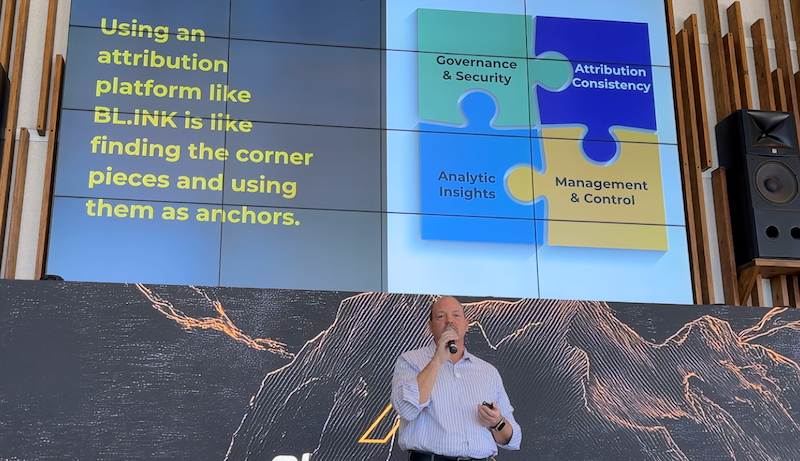
Listen to this blog
Accelerate Decision-making by 25% with Unified Attribution
Achieving Unified Marketing Attribution in a Fragmented Ecosystem: Key Insights from Andy Meadows at ObservePoint’s EDGE Conference 2024
In today's multi-channel marketing landscape, brands face a complex challenge: stitching together data from diverse sources to form a clear, actionable picture of the customer journey. This was the core message delivered by Andy Meadows, CEO of BL.INK, during his insightful presentation at ObservePoint’s EDGE Conference in September 2024. His presentation, titled "Piecing Together the Puzzle of Marketing Attribution: A Unified Approach for Fragmented Ecosystems," offered marketers a roadmap to overcoming the hurdles of disconnected data and fragmented attribution models.
The Puzzle of Fragmented Data
Marketing today is an intricate puzzle, with pieces coming from a variety of channels—social media, email, paid ads, and more. Each of these generates its own data silo, making it difficult to unify insights and accurately measure ROI. Meadows likened this challenge to “getting pieces from 10 different puzzles, and none of them fit together.” This fragmentation often leads to budget misallocation, compliance risks, and a weakened customer experience.
But, as Meadows emphasized, solutions like BL.INK offer a way forward. BL.INK standardizes and centralizes tracking across all touchpoints, transforming the marketing ecosystem from disjointed chaos to a cohesive, unified system. This unified approach makes it easier to collect, normalize, and analyze data, enabling more accurate reporting and clearer insights into the customer journey.
Why Multi-Touch Attribution Matters
Meadows highlighted multi-touch attribution (MTA) as the emerging gold standard for marketers seeking to optimize customer journeys across multiple touchpoints. MTA allows marketers to see how different interactions contribute to conversions, helping them allocate budgets more effectively. Yet, as he pointed out, only 17% of marketers currently feel confident in their attribution models—a gap that BL.INK aims to bridge by providing a single source of truth for marketing performance.
Unified Attribution in Action
BL.INK’s value proposition is exemplified through case studies with leading brands like Coca-Cola, Bank of America, and Room & Board. Coca-Cola used BL.INK to standardize link tracking across global and local campaigns, maintaining consistency while optimizing for local relevance. Similarly, Bank of America leveraged BL.INK to ensure GDPR and CCPA compliance, reducing risks related to privacy and audit processes.
Meadows also discussed how Room & Board solved a common challenge: connecting the dots between digital and in-store touchpoints. With BL.INK’s centralized tracking, Room & Board was able to gain clearer visibility into their customer journey, resulting in more accurate reporting and a better understanding of how customers interacted with their brand across platforms.
The Benefits of a Unified Attribution Strategy
According to Meadows, adopting a unified attribution strategy delivers a range of benefits, including:
- Improved ROI measurement: With centralized, standardized tracking, marketers can see which efforts are truly driving value.
- Enhanced customer experience: By linking touchpoints, brands can deliver more relevant and personalized experiences.
- Better budget allocation: Accurate data leads to smarter spending decisions.
- Increased compliance and privacy protection: With privacy regulations tightening worldwide, having a compliant, standardized system is non-negotiable.
In fact, Meadows referenced research showing that unified attribution systems improve ROI by 20% and accelerate decision-making by 25%.
Moving Forward with Unified Attribution
For marketers ready to tackle the puzzle of attribution, Meadows provided actionable next steps:
- Standardize and centralize tracking with a tool like BL.INK.
- Choose the right attribution model based on your campaign’s goals.
- Implement centralized reporting to get a clear picture of performance.
- Ensure compliance and privacy at every touchpoint.
- Deliver hyper-relevant customer experiences with confidence.
In his closing remarks, Meadows stressed that attribution is no longer just about clicks and conversions—it’s about understanding the full customer journey in a privacy-conscious world. For marketers looking to overcome the challenge of fragmented data, BL.INK’s unified attribution solution offers the key to solving the puzzle.
If you missed the presentation, you can still access the deck, a joint webinar with ObservePoint and Room & Board, and an opportunity to meet with Andy Meadows by clicking here.



